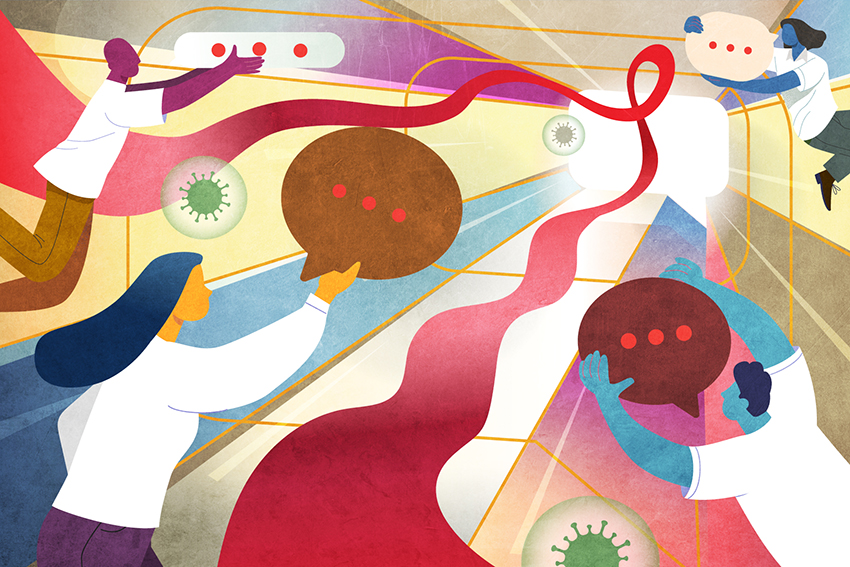
Photo Credit: Darrell Stevens/FHI 360 Design Lab
While COVID-19 has been at the center of health concerns since early 2020, the fight to end HIV continues. How are HIV communicators in the United States effectively engaging with their priority audiences? Here, four HIV communicators explain why they are passionate about their work and discuss how, in the current environment, they can best reach people in the United States who historically have had to bear the largest burden of HIV.
FHI 360’s social marketing and communication staff supports initiatives and campaigns on sexual health and HIV in the United States, including communication and creative services for Let’s Stop HIV Together, the U.S. Centers for Disease Control and Prevention’s national media campaign.
What motivates you as creative communicators working on such a critical issue?
Kevin: I lived most of my childhood homeless and in communities impacted by HIV, diabetes and other health issues, so I know from personal experience that health communication matters. Sharing information with communities and advocating for greater community representation motivates me to show up every day and promote healthier behaviors.
Victor: I’m a member of different communities that are heavily impacted by the HIV epidemic, and our work is rewarding for me on a personal level. Because HIV has been so stigmatized throughout the decades, our work in HIV communication has the potential to not only keep people healthy and living longer, but also to change attitudes, challenge stereotypes and reshape public opinion about HIV.
Makaila: Identifying as a woman of color — and also as someone whose family and community have experienced first-hand the effects of HIV — I am passionate about the work we do because I help amplify the voices of others with stories similar to mine. Integrating racial and health equity messages is key. We need to shed a light on the historic systemic barriers to prevention and care and be proactive in offering solutions.
You engage with communities throughout the U.S. about HIV. How has connecting with partner organizations and community members helped you to reach priority audiences?
Julianne: By building relationships with trusted community organizations and leaders, we are better able to share information and resources on HIV with specific audiences. For example, we partnered with Living Walls, an Atlanta-based public arts nonprofit organization, to organize events. Living Walls engaged other partner organizations to reach priority audiences, including the LGBTQ+ Latinx community and the gay and bisexual African American/Black men community.
Kevin: Through that partnership, we also collaborated with local community organizations to engage Atlanta’s house ballroom community — an underground LGBTQ+ subculture, originated by young African Americans and Latin Americans in New York City, where members compete at festive events known as kiki balls. The Chop The Stigma Kiki Ball (which was held before the pandemic) included competition categories about HIV resources and misconceptions.
Victor: In general, our partnerships strive to achieve campaign goals while bringing value to the communities we work with. The events we support often provide on-site HIV testing as well as art and entertainment, appealing to individuals who might not seek HIV information and education on their own.
In an environment that is saturated with health information, how can HIV communicators ensure that HIV information is getting through?
Victor: By being hyperfocused about reaching specific audiences through strategic partnerships and tailored messaging, we can ensure people get the HIV information they need — even when COVID-19 information is front and center. Social media influencers are key to reaching certain demographics, like Gen Z. By working with diverse groups of influencers, we can increase HIV awareness among our priority audiences and the general public.
Makaila: To keep the focus on HIV during the pandemic, we’ve made sure that our HIV communications are authentic and inclusive, tapping into platforms like TikTok, Instagram and Twitter. So when we have conversations about how HIV impacts individuals and communities — who likely are struggling due to the pandemic — people’s experiences will be at the forefront.
Julianne: As COVID-19 continues, we must work harder than ever to meet people where they are: engaging with communities virtually, seeking their input when we develop resources intended for their use, and giving our audiences a platform, like community listening sessions, to share their opinions.
Kevin: Messages must come from the community for the community. The experts are the HIV advocates who have dedicated their lives to the cause. Our job is to elevate and amplify their voices to help them reach audiences — especially now, when people are receiving a lot of health information.
